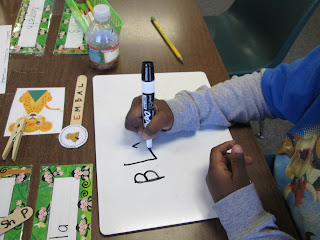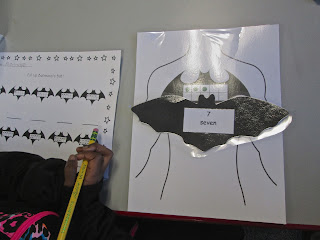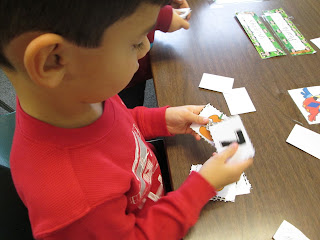Here's a little look at our seasons unit:
One of my favorite projects of the year is a follow up of the book Leaf Man by Lois Ehlert. Leaf Man discusses all the uses for and beauty of fall leaves in a wonderful and engaging picture book. So cute!
Here's a look at our leaf men and our written descriptions.
We use white art trays, liquid glue and q-tips (to avoid glue disasters) and eyeballs, toothpicks gems, small colored squares and buttons to decorate our leaf men (which I bought at Christmas Tree Shops).
Our leaf men hall display!
At the end of our unit, we compile our knowledge of each of the seasons by decorating each season's tree to show the characteristics of the season. We use finger paint and cotton balls to keep it simple but you could use any materials ! (I'm not the most artsy..)
Here's a look at our farming unit:
I don't know WHY I have no picture of the final project.. but here the bees are coloring, cutting and forming their Fall cornucopia. We use these cornucopia before Thanksgiving so that I can separately teach its value from the events of the pilgrims and the Native Americans. Fall farming and harvest is the unit that precedes Thanksgiving and they are expected to know crops that are harvested in the spring, summer, and especially the Fall. After creating a list of Fall crops, we create our Fall harvest cornucopia filled with a Fall harvest to help us remember!
We also stray from the Scott Forseman readers during our Farming unit and use some focused on the farm from Reading A-Z. I LOVE that they have a reader about farming for each of the reading levels.
This is how I pre-teach difficult vocabulary and review previously learned words at reading groups. I prop up the white board while we're reading so the bees can refer to it while they read.
Possibly my favorite part of these A-Z readers.... blank pages for story creation/continuation at the ends of each book! This allows me to check for comprehension, add in a writing component, and get the kids excited to become authors!
Here's a look at our pumpkin mini study:
At the end of our farming unit, and conveniently close to Halloween, we focus on one Fall crop... PUMPKINS!
We become researchers and use magazines, informational texts, and online videos to help us understand and learn how pumpkins grow and reproduce, the names of their inside and outside parts, and how people and animals use this fruit. Just the fact that it is indeed a fruit is crazy!
Here's our KWL chart to focus our learning and gather what we already know. On the right, some scientists using a TIME magazine to research and learn about pumpkin uses.
We use these sequencing cards to order the life cycle of a pumpkin. Love the idea of visuals and writing to appeal to both my readers and non-readers alike. Prior to this activity we watch a video on the growth of a pumpkin and then read Pumpkin, Pumkpin so that we have a more solid understanding to order our sequencing cards. The following day we sequence the cards a second time and color, cut, and paste our very own pumpkin life cycle for an easy assessment.
Labeling the pumpkin parts
On our last day of pumpkin research and exploration, which always happens to be our Halloween party, we finally take apart our pumpkin and explore the inside! We first read How Many Seeds in a Pumpkin to find out how to organize a pumpkin exploration and preview what might be inside OUR pumpkin. We talk up these recording sheets as "real scientists need to record all of their results so that they can remember and learn from their observations." On these "pumpkin observation" sheets, students label our pumpkin, sketch it, describe it in three adjectives, write its height, tell whether it floats and finally make an estimate and then count the number of pumpkin seeds it contains.
Here we are exploring the skin, stem, and shape of the pumpkin.
Measuring and recording pumpkin height
FINALLY discovering the insides!
Then we reach inside, and separate the brains from the seeds in preparation for our seed counting! This is the perfect time to talk about adjectives and even record their words.
I use tissue paper circles to help the bees count out ten seeds at a time and then we use our hundreds chart to count by tens until all of the groups are counted. (I confess, I throw so many of our seeds out to ease the counting load..)
Some of our Fall writing:
When we first learn about informational text, I allow the children to pick any animal that they know about and write an informational piece.
Here, K is using a book from our library to draw a more realistic picture of the lion she is writing about.
E couldn't find a penguin book in our library so we opened up Google and researched penguins together.
Thought these chameleons were adorable!
I THINK we finally understand the word wall. This year, I used library pockets labeled with the sight words and matching popsicle sticks to serve as our word wall. The idea is that while they are writing, they can come up, grab the needed sight word, and then bring it to their seats to write it. So far, so good !
Bought these "spacemen" from Really Good Stuff and we LOVE them. They are really fun and make sense (SPACEmen) so the bees seem to use them often.
I believe, especially for my ELL students and others who may still be learning the alphabet, learning how to draw well is important. Many Kindergarteners can become frustrated with writing time because they are not yet able to use words to share their ideas and must so must use pictures to do so. After reading The Pigeon Finds a Hot Dog, we discuss the shapes Mo Willems may have used to draw Pigeon. We then slowly draw him in a directed drawing experience. They are SO proud of their results!
Here we are learning some prewriting strategies!
And a writing miracle! One morning, after finishing their literacy stations, one of my students asked if they could finish their work in their morning journals (where they write a story to me each day). Up until now, the journals were very demanding of new Kindergarten students but this day, as I was organizing for the afternoon, they all quietly walked to get their journals and began writing their stories. When i discovered exactly what they were doing I was so proud! I am so happy that the every day exposure to the journals has created in them some excitement and interest in writing!
Heres a look at some of our literacy stations this month:
letter and beginning sound candy corn
rhyming pumpkins and recording sheet
Of course, some alphabet bingo. Easy to differentiate (some students were working on letter naming and others were doing letter sounds or words that begin with that letter)
Love these! alphabet quick reads. The bees roll a die and then read off the letters in that row as fast as they can. The higher students at this table read off the letter sounds.
Some friends are having a difficult time with specific letter so this roll and graph station, focused on just 6 (or less if you choose) letters helps them review and practice only the tricky ones.
One of our favorites, Moose! The children take turns picking a letter stick, saying its name or sound, and then writing the letter (so many skills!). When they pick a stick with a moose, they have to throw all of their letters back in the cup and erase their board!
Fishy upper to lowercase letter match
Part of our alphabet bootcamp packet from The Kindergarten Smorgasboard! Beginning sound cards. Students use their letter-sound knowledge to identify and write the beginning sound of each of the pictures.
Here we are identifying the number of syllables in a word using fall stamps.. how fun!
More stamping! This is our grab, read, write, and stamp sight word center.
Love these cards for beginning blenders. We use different colored cubes to mark the vowels and consonants of each of the words and add a cube for each sound we say aloud. After each sound is said, the students attempt to blend and read.
Sight word grab, read, build, and write center with scrabble tiles.
Sight word grab, read, and build with alphabet beads
At this center, the students are clipping the beginning sound of the word in the picture. If they can, they can clip the ending and even the middle sound.
Students who can name all of the sound in the words can try and write the word after clipping
and of course, some rhyming matching practice!
Math Centers:
Count and write with the aid of my favorite....write and wipe number lines from Lakeshore!
Here they are rolling and recording and learning how to create and read graphs. Its Johnny Appleseed themed!
We are learning one to one correspondence and number quantity in this seed counting center!
And of course, we need a little batman in our superhero obsessed classroom.
Here the bees are identifying the number represented on bat man's chest plate and then finding how many more he needs to fill his chest plate completely (to fly). They are to match the ten frame to the number bat that represents how many more and then record it on their recording sheet.
In this station, the pictures are placed according to position words. Great assessment!
This center is a great fine motor and number to quantity practice. Another possible assessment... see they can be fun!
Representing numbers in ten frames with 80's pictures! I have to admit... I got A LOT of "what's this?" to the cassette and boom box pictures...
A space race! Number Id land and say board game.
Ten frame to number matching game.
Another fun Halloween themed center. Here the students pick a number cave, use purple and green bats to fill the cave to equal the number above the cave and then write the math equation to represent it. In this picture, E is writing that 4 is 2+2.
Pumpkin ten frame pick, count, and record
Halloween count and write mini book
Domino add and glue under the sum. Love that this center shows many ways to make each number.
Turkey number to quantity color. Such a simple station, but Kindergarteners love to color!
Nutty about numbers game.. here, the students pick a card, count the acorns and then move across the board.
Shape roll and graph... but for a little added fun, we graphed using buttons! This also helped cut down the number of paper copies I had to make...
And FINALLY.......we got a visit from the Pumpkin Man! I mentioned there might be a visitor in our classroom after our Halloween party if he thought we were a well-behaved and friendly class. And look! He came :)







































































